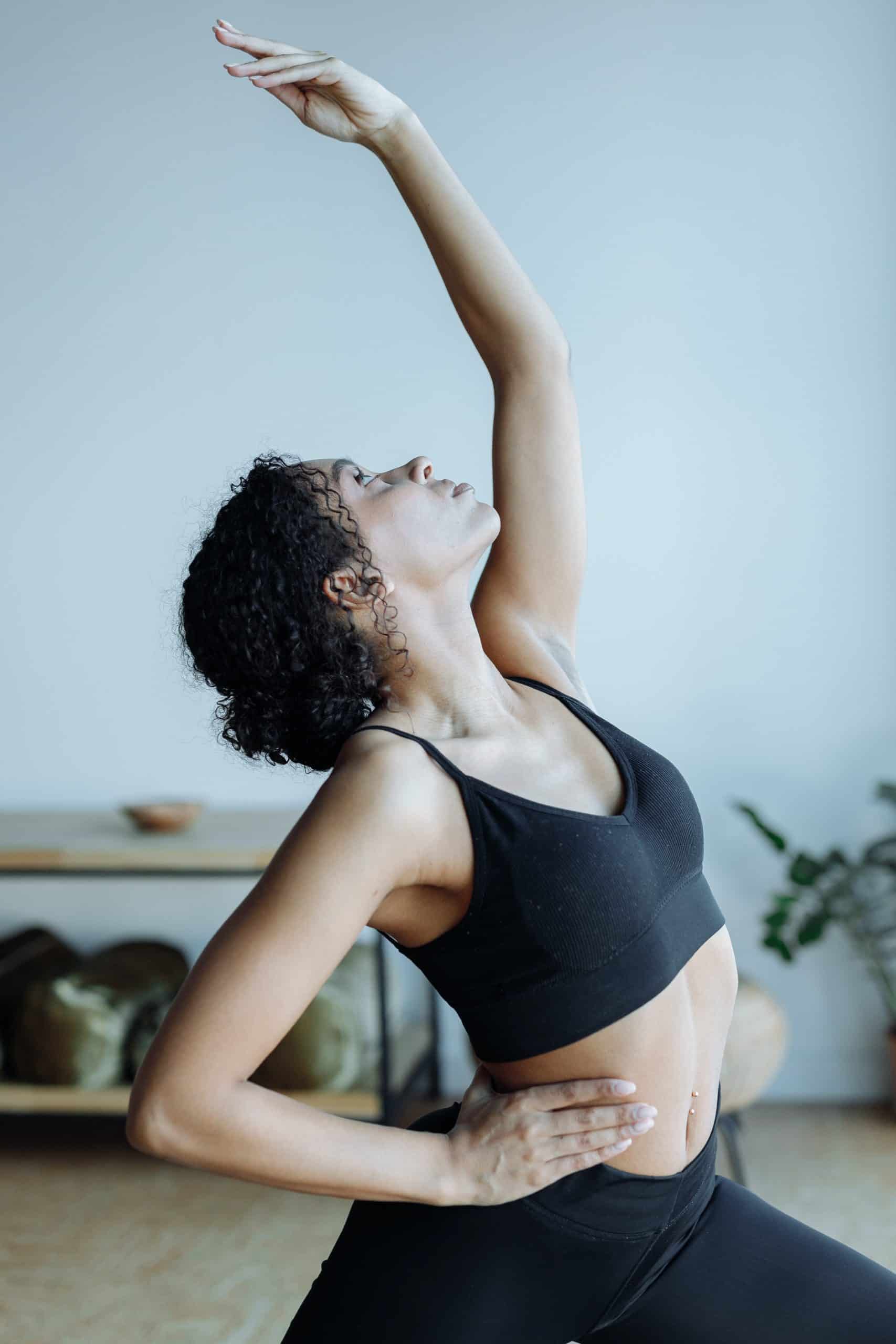
The connection between yoga and acting
Yoga and acting appear to be two distinct realms, yet they have a profound connection beyond physical exercise. Both require alertness, discipline, and the capacity to bond with oneself and others. Incorporating yoga into their practice helps actors become more aware of their bodies, emotions, and the ability to be in their characters’ shoes.
Acting calls for embodying different personalities and emotions, and yoga offers actors a potent way to explore their own bodies and sentiments. Through diverse poses and breathing exercises, yoga assists actors in releasing pressure, bettering flexibility, and developing a sense of presence on stage or in front of the camera.
Apart from its physical benefits, yoga also bolsters an actor’s psychological and emotional health. Mindfulness in yoga guides actors to stay in the present, letting go of any disruptions or preconceived thoughts. This ability to remain present permits actors to attentively listen, truthfully answer, and genuinely interact with their scene partners.
In addition, by bringing meditation into their daily life, actors can comprehend themselves and their characters more profoundly. Meditation motivates self-contemplation and introspection, qualities which are fundamental for a credible performance.
According to Harvard Medical School’s Benson-Henry Institute for Mind-Body Medicine, practicing yoga can reduce anxiety levels and better overall well-being. This research confirms that yoga can be an effective tool for actors to cope with performance-related stressors like audition nerves or stage fright.
The Benefits of Yoga for Actors
To enhance your acting skills, harness the power of yoga. Experience the benefits of yoga for actors, including the physical and mental advantages it offers. Discover how yoga can improve your physical strength and flexibility while also cultivating mental focus and emotional well-being. Unleash your potential on and off the stage with the connection between yoga and acting.
Physical Benefits of Yoga
Yoga provides many physical advantages for actors, improving their acting in theatre and films. These include increased flexibility, stronger muscles, and better posture.
- Flexibility: Yoga increases the body’s range of motion and suppleness. This is essential for actors who often have to do difficult movements or poses.
- Strength: The postures in yoga require strength and steadiness. Actors can build a stronger core, firmer muscles, and an overall better body by regularly practicing yoga.
- Posture: Yoga focuses on proper alignment and stance. Good posture enables actors to look more confident and reduce the danger of hurting themselves during performances.
Apart from these famous benefits, yoga has lesser-known ones too. Such as, it can help improve breath control and lung capacity. This is key for actors because they need this to project their voices powerfully and give long speeches without running out of air.
For maximum benefit, actors should think about the following:
- Include dynamic flows: Dynamic flowing sequences in yoga exercises can imitate the fluidity needed in acting.
- Concentrate on balance poses: Balancing poses, like tree pose or warrior 3, help actors develop physical stability and mental focus.
- Do mindful breathing techniques: Studying various pranayama techniques can boost an actor’s ability to manage their breath on stage.
By following these tips, actors can exploit the physical advantages gained from yoga in their training.
Improved Flexibility and Strength
Yoga grants actors various advantages, one of them being increased flexibility and strength. This physical transformation lets them move gracefully in front of the camera or on stage, boosting their performances.
- Amplified Mobility: Yoga loosens tight muscles and augments joint flexibility, granting actors a larger range of motion. This lets them pull off strenuous physical tasks with ease, mesmerizing the audience with their graceful motions.
- Heightened Core Strength: Practicing yoga regularly helps actors build a powerful core. This is necessary for balance and stability and aids in performing stunts, acrobatics, or dance routines perfectly.
- Boosted Body Awareness: Yoga increases body awareness among actors, allowing them to comprehend their physical limitations and strengths. This self-understanding helps them portray characters realistically and express emotions aptly through their bodies.
- Reduced Risk of Injury: Yoga strengthens and boosts muscular endurance, diminishing the danger of harm amid strenuous rehearsals or performances. With a healthy body that’s immune to injuries, actors can deliver stellar performances without interruption.
Engaging in yoga not only upgrades flexibility and strength but also gives actors extra benefits that benefit their performance. The mental focus required during yoga practice sharpens an actor’s concentration abilities, enabling them to stay present in the moment while performing. Moreover, yoga promotes relaxation and stress management techniques that help actors find inner peace even in tough roles or stressful scenarios.
True Story:
Mila was an aspiring actress who had difficulty with her physical abilities until she found out about the power of yoga. Regular practice enabled her to gain remarkable flex and strength over time. During an audition for a physically demanding role in a stage production, her new flexibility allowed her to perform intricate choreography with ease. Her performance was so remarkable that the audience gave her a standing ovation, solidifying her success as an actress. Yoga changed Mila’s career, making her a formidable presence on stage.
Posture and Body Awareness
Posture and body awareness are must-haves for actors. Through proper posture and body awareness, they can bring life and grace to their performances. We’ll explore three key ways yoga helps with posture and body awareness:
- Alignment: Yoga teaches actors how to line up their bodies correctly. By doing various asanas (poses), they learn about their bones and how they affect their stance.
- Core strength: Yoga focuses on building core muscles, like the abdomen and back. With a strong core, actors can maintain good posture easily. Plus, they won’t get hurt from bad alignment during tough scenes.
- Breath control: Yoga emphasizes deep breathing and breath control. With pranayama (breathing exercises), actors become more aware of their breathing. This awareness gives them better control over breathing during intense scenes, helping with vocal projection and emotion.
Yoga also boosts body awareness. Doing flows of movements and transitioning between poses increases proprioception. That’s the ability to know one’s body position without looking.
To get the best out of yoga for posture:
- Do standing poses like Mountain Pose to focus on alignment and balance?
- Add core-strengthening poses like Boat Pose or Plank Pose to your routine.
- Spend time on breathing exercises like Ujjayi Pranayama or Nadi Shodhana Pranayama to sharpen breath control.
By regularly following these steps, actors can use yoga to develop amazing posture and body awareness. These practices not only give them an attractive presence on stage but also promote physical well-being, unlocking their potential.
Breath Control and Voice Projection
Actors need to learn breath control and voice projection. Through yoga, this can be enhanced. Here is a 6-step guide to help:
- Deep Breathing: Find a comfy spot. Inhale through your nose, and let your belly expand. Exhale slowly through your mouth, release tension.
- Diaphragmatic Breathing: Place hands on chest and belly. As you breathe in, focus on expanding your belly, not your chest. This engages deep abs for better breath support.
- Vocal Warm-ups: Before vocalizing, warm up your vocal cords. Do gentle hums and sirens, and increase volume and pitch.
- Posture Alignment: Stand tall, shoulders relaxed, spine and head aligned. This allows for better airflow and resonance.
- Voice Projection Exercises: Start with simple phrases or sentences. Focus on articulating each word, use proper breath support, and gradually increase volume without forcing it.
- Incorporate Yoga Poses: Certain poses open the chest cavity, and improve lung capacity. Try Cobra Pose (Bhujangasana) or Fish Pose (Matsyasana).
Yoga helps reduce stress and tension, improving vocal performance. Plus, mindfulness, core strengthening exercises, and vocal training can help too. With daily practice, actors can master breath control and voice projection for powerful performances.
Mental Benefits of Yoga
Yoga has many mental benefits that help actors stay settled, manage stress, be creative, and grow self-trust. Plus, it offers special perks.
Focus: Yoga helps minds stay in the present and be more focused when acting.
Stress Management: Yoga has breathing exercises and relaxations to help actors release tension and be less anxious when working.
Creativity Enhancement: Yoga stimulates energy and imagination, making artists open to new ideas.
Self-Confidence Boost: Yoga makes actors feel secure in their bodies and more genuine when acting.
Emotional Resilience: Yoga encourages inner reflection and emotional intelligence, so actors can still be stable while dealing with emotions while performing.
It also brings better sleep and better posture, reducing the odds of being hurt during physical performances.
Emma is a great example of the power of yoga. She was an artist with trust issues and decided to try yoga. After regular practice, she found confidence and learned how to manage performance anxiety. This shows how yoga’s mental benefits can improve actors’ careers.
Increased Focus and Concentration
Yoga is key for actors to hone their craft. It offers many benefits that focus and sharpen concentration.
- Connects Mind and Body: Yoga encourages mindfulness and awareness so that actors can stay present and totally in the moment.
- Sharpens Mental Clarity: Breathing exercises and meditation help actors make decisions faster and access emotions better.
- Reduces Distractions: Yoga teaches letting go of distractions and staying in the present. This helps actors remain concentrated during rehearsals or shows.
- Boosts Attention Span: Regular yoga strengthens the brain’s power to concentrate, so actors can take on complex scenes or long monologues easily.
- Strengthens Concentration Muscles: Yoga poses require focus and balance, improving the brain’s ability to focus at auditions, rehearsals, and performances.
- Promotes Relaxation: Relaxation is key for optimal focus. Yoga’s relaxation techniques reduce stress and create a calm state of mind, so actors concentrate better.
Plus, yoga aids in boosting spatial awareness. Actors need this to move around the stage without being distracted. To get the most out of yoga, do these:
- Practice regularly – Consistency is crucial for getting the rewards of yoga. Set aside time every day.
- Do breathwork exercises – Deep breaths not only oxygenate the brain but also soothe the nervous system to improve focus.
- Try mindfulness meditation – Cultivating an unwavering presence of mind through meditation helps sustain focus and attention.
- Designate a practice space – Having a space for yoga eliminates distractions and helps concentration.
By following these tips, yoga can be an effective tool for actors to increase focus and concentration. So unroll the mat and let your performance shine with laser-like focus!
Stress Reduction and Emotional Balance
Yoga for Actors is a powerful tool for managing stress and emotions. Incorporating yoga into their routine, actors gain improved mental well-being and greater emotional awareness. Through various techniques, yoga helps them find inner peace, manage stress effectively, and stay emotionally stable.
Moreover, yoga offers additional benefits for stress relief and emotional balance that suit an actor’s lifestyle. Regular practice not only promotes physical well-being but also cultivates mindfulness and introspection. These are essential for navigating the demanding entertainment industry.
Pro Tip: To get the most out of yoga for stress reduction and emotional balance, actors should try poses such as Child’s Pose or Corpse Pose in their pre-performance routine. These can help relax the body and mind before performing.
Building Confidence and Self-Awareness
Building Confidence and self-awareness are crucial for actors. It helps them access their emotions, identify their strengths & weaknesses, and present themselves honestly.
Yoga aids actors in:
- 1. Exploring Emotions: It empowers them to experience various feelings & dive deep into different roles.
- 2. Improving Body Language: It enables them to control their motions & portray gestures & poses precisely.
- 3. Creating Presence: It teaches them to be mindful in the moment, building connections with fellow cast members & captivating audiences.
- 4. Handling Performance Anxiety: It equips them with techniques to stay calm, concentrate, & deliver confident performances.
- 5. Growing Self-Awareness: It helps them reflect & get to know themselves better, bringing more depth to their characters.
Plus, yoga can help with vocal projection & breath control.
Research conducted by UCLA found regular yoga practice can reduce stress & increase mindfulness, positively affecting an actor’s overall well-being.
Stella Adler, an acclaimed acting coach, believes yoga can lead to better physicality & emotional availability in performances.
The Connection Between Yoga and Acting
To enhance the connection between yoga and acting, delve into the similarities in technique and approach, and explore incorporating yoga practices into an actor’s training. The former highlights how yoga and acting share fundamental aspects, while the latter focuses on utilizing yogic principles to enhance an actor’s skills and overall performance.
The Similarities in Technique and Approach
Yoga and acting seem very different, but they actually share a lot. Both require body awareness, emotional connection, and balance.
In yoga, postures are practiced with precise alignment and breath control. Actors also use physical gestures, like movements, to convey emotion. Yoga and acting both use breathwork to calm the mind and create performances that resonate.
Both practices also focus on vulnerability. Yoga poses make practitioners let go of inhibitions and open up physically. Actors must expose their innermost thoughts and emotions to portray characters.
To make the connection between yoga and acting stronger, here are some tips:
- Incorporate yoga into your warm-up routine before rehearsals or auditions.
- Explore yoga poses that align with the character’s emotions.
- Use yoga breathwork to improve vocal work.
- Attend workshops or classes that combine elements of yoga and acting.
By combining yoga and acting, actors can access a deeper level of physical and emotional awareness. Exploring the connection between the two can transform performances and help actors connect with their characters. So, why not take advantage of this connection?
Breathwork and Vocal Techniques
Breathwork and vocal techniques are essential for both yoga and acting. They are key in boosting performance plus connecting with oneself and the audience. Here are the four main points to understand their value:
- Breathwork: Yoga emphasizes deep breathing exercises. This helps actors control their breath when they’re onstage. This enables them to deliver their dialogues with the proper pauses, inflections, and emotions.
- Vocal Warm-ups: Warm-up exercises like tongue twisters and vocal scales help actors improve their resonance, projection, and diction. These techniques guarantee clarity of speech and make dialogue delivery more powerful.
- Body Awareness: Yoga increases body awareness, allowing actors to carry themselves with grace and poise. This helps them convincingly portray characters by synchronizing physical movements with the desired emotions.
- Presence: Both yoga and acting need a presence at the moment. Concentrating on breathwork motivates mindfulness, allowing actors to be totally present during performances and respond honestly to their co-actors.
In addition, breathwork not only toughens lung capacity but also creates a relaxed state of mind that is helpful for both yoga practitioners and actors. It brings a feeling of serenity, helping performers cope with stage fright.
Pro Tip: Incorporate breathwork into your daily routine. Practice deep belly breathing while rehearsing lines or before auditions. This will aid you to employ the power of your breath as a significant tool in your acting toolbox.
Presence and Mindfulness
Yoga and acting share a strong bond when it comes to presence and mindfulness. Both practices call for individuals to be in the here and now, aware of their body, feelings, and environment. Through yoga, actors can bring extra sharpness and credibility to their performances.
Yoga is a tremendous aid for actors to develop a profound sense of presence while on stage or in front of the camera. Through consistent practice, actors learn to pay attention to their breath and body sensations, keeping themselves in the present moment. This helps them to shrug off distractions and exterior pressures, enabling them to take on their character and make a deeper connection with their scene partners.
On top of that, yoga instructs actors to cultivate mindfulness in each aspect of their craft. From voice modulation to physicality, actors make use of conscious techniques gained from yoga practice to improve their performances. By being totally present and conscious of each movement and expression, they can deliver more genuine and detailed depictions.
A study completed by Stanford University researchers observed that integrating yoga into actor training resulted in better concentration, emotional regulation, and overall performance quality. The study showed that actors who practiced yoga experienced higher levels of mindfulness, which translated into more engaging performances and a stronger bond with the audience.
All in all, the bond between yoga and acting goes beyond physical gains. It is an interconnected practice that nourishes the mind-body connection vital for successful performances on stage or screen. By embracing presence and mindfulness through yoga, actors can unlock their total potential as performers.
(Source: Stanford University Research Study)
Body and Movement Exploration
Body and Movement Exploration is essential for yoga and acting. With this practice, you can explore your body’s potential for expression and movement. Here are five points to understand about this connection:
- Awareness: Through Body and Movement Exploration, you can gain a deeper understanding of yourself and your body. This allows actors to inhabit their characters more fully and express themselves genuinely.
- Flexibility: Both acting and yoga need flexibility, both physically and mentally. With practice, you can learn how to extend beyond your limitations, increasing your range of motion and emotive expression.
- Breathwork: Breathing exercises are vital to both yoga and acting. By using the power of breath, you can access the energy required for physical and emotional intensity. This increases movements with grace and accuracy.
- Improvisation: Body and Movement Exploration invites you to explore new ways of moving, reacting, and embodying a character in the moment. This allows actors to respond truthfully on stage and provides yogis with personal growth opportunities.
- Emotional Release: Doing physical activity through yoga or acting can bring out pent-up emotions in your body. The exploration of movement gives you the chance to release emotional blockages, leading to a sense of freedom, authenticity, and vulnerability in your practice or performance.
To take your body-mind connection further, consider joining yoga and acting exercises that focus on physicality, emotion, and character development. This can help you become a better actor or strengthen your bond with your body during yoga sessions. Remember, the key to success is embracing your creative potential through these practices.
Incorporating Yoga Practices into Actor’s Training
Yoga and acting are two disciplines that may seem unconnected, but in reality, they are strongly related. Many actors have started to use yoga in their training as it has many benefits.
Yoga helps to develop physical strength and suppleness. The poses and movements require the body to stretch and strengthen. This makes it easier for actors to move with ease and grace on stage or in front of the camera. It also helps to improve posture, which is essential for believable character embodiment.
Yoga additionally gives mental clarity and concentration. Through breathing exercises and meditation, actors can learn to concentrate and be present. This heightened awareness can help them connect with their emotions and be more creative. It also helps them stay calm in the chaos of rehearsals or performances.
Yoga can also enhance vocal performance. Breathing techniques can increase breath control and lung capacity, allowing actors to project their voices better. These techniques can also help manage nerves or stage fright by calming the nervous system.
Using yoga in actor’s training is easy. Here are a few tips:
- Start with Sun Salutations to warm up the body.
- Practice standing poses like Warrior I or Tree Pose to improve balance and grounding.
- Do seated poses like Forward Fold or Camel Pose to release tension in the hips and back.
- Try breathing exercises like Alternate Nostril Breathing or Ujjayi Breathing for mental focus.
- Allocate time for meditation at the end of each session to cultivate mindfulness.
These suggestions work because they target specific areas that are essential for an actor’s development – physical strength, flexibility, vocal performance, mental focus, and emotional grounding. By using these yoga practices in their training, actors can reach new heights and create a comprehensive approach to their work.
Warm-Up and Body Awareness Exercises
Warm-ups and body awareness exercises are essential for both yoga and acting. They boost physical coordination, flexibility, and mindfulness. These exercises ready the body and mind for yoga or acting, guaranteeing optimal performance.
- Stretch: Mild stretches loosen up muscles, increase flexibility, and keep injuries away during yoga or acting.
- Breathe: Deep breathing increases lung capacity, and oxygen to the brain, reduces stress, and helps with vocal control for actors.
- Core Workouts: Exercises that strengthen the core muscles like planks in yoga or abs exercises for actors, enhance stability and posture.
- Balance: Yoga postures like tree pose or one-legged standing poses help actors develop the balance needed for stage performances.
- Mindfulness: Yoga’s focus on body awareness and mindfulness makes actors connect with their physical sensations during performances.
- Energize: Dynamic warm-ups like sun salutations in yoga or energizing movement sequences for actors, help wake up the body before practice or a performance.
Also, warm-up sessions should be personalized according to individual body types, injuries, or preferences. People can consult yoga instructors or movement coaches who specialize in getting actors ready for performances.
It is noteworthy that Stella Adler, an acclaimed acting coach, included elements of yoga in her teaching. She understood the link between breath control and emotional expression in acting. So, she integrated yoga exercises into her approach. This integration assisted students in developing more body awareness and authenticity in their performances.
Improving Character Work and Emotional Expression
Yoga is a great way to improve character work and the emotional expression of actors. Yoga helps actors understand their characters better, access wider ranges of emotions, stay focused, and experience personal growth. Matthew McConaughey is an example of an actor who used yoga to help him portray his character in “Dallas Buyers Club“.
Yoga aids the physical and mental aspects of acting. It increases body awareness, so actors can portray physicality and mannerisms more effectively. It also provides emotional access, as well as discipline and focus.
Yoga also has tools for self-discovery. Through introspection and reflection, actors come to know themselves better. With this knowledge, they can bring more depth to their characters.
In conclusion, yoga can be a powerful aid for actors. It helps them in character work, emotional expression, focus, and self-discovery. It’s clear why so many actors rely on yoga to enhance their performances.
Enhancing Performance Presence and Authenticity
Performance presence and authenticity are essential in both yoga and acting. Yoga helps actors connect to their emotions on a deeper level. Through focusing on breathing, body awareness, and mindfulness, actors can access a state of presence. This presence lets them fully embody their characters.
In acting, presence is crucial. It allows for genuine performances. Yoga teaches individuals to be aware of their bodies and minds. Through poses and movements, actors become attuned to physical sensations. This self-awareness leads to more authentic performances.
Authenticity is an important element yoga brings to acting. Yoga encourages practitioners to embrace their true selves. This practice carries over into acting, allowing actors to portray characters with sincerity and truthfulness. Yoga helps actors access their own vulnerabilities and experiences, making their performances more relatable.
Yoga provides a safe space for actors to explore different parts of themselves. It lets them dive into emotions, unlocking new levels of vulnerability and authenticity. In this way, yoga is a valuable tool for self-discovery within the realm of acting.
Testimonials from Actors Who Practice Yoga
Yoga can make actors more flexible, helping them with physical ability and focus. It also reduces stress and anxiety, letting them handle pressure better. Additionally, it strengthens their breathing, optimizing vocal control.
This practice offers self-awareness, allowing them to connect with emotions in a deeper way. This inner exploration helps with authentic performances and character development. Plus, it cultivates discipline and perseverance, essential for honing their craft.
So, actors should add yoga to their routines for better well-being and artistic growth!
Conclusion
In the world of acting, yoga has a deep connection. This ancient practice focuses on physical and mental well-being and is seen as a powerful tool for performers. By doing yoga daily, actors can improve their flexibility, balance, and physical presence.
Yoga helps more than just the physical side. It also cultivates mindfulness and inner awareness. This aids performers to connect better with their characters and access genuine emotions during performances. Breathwork and meditation also help actors control their minds and bodies, resulting in better portrayals.
Yoga and acting both emphasize vulnerability. Practitioners are encouraged to embrace it, leading to intense and emotionally resonant performances. Yoga gives actors a safe space to explore their vulnerabilities and access deeper emotions in their work.
Famous actors have credited their success to yoga. Sir Anthony Hopkins said his yoga routine helps him stay focused. Jennifer Aniston has spoken about how it helps her find balance. These stories show the profound impact yoga can have on an actor’s journey.
Frequently Asked Questions
1. How does yoga benefit actors?
Yoga benefits actors by improving their physical and mental well-being. It helps increase flexibility, strengthen the body, and improve posture, which is crucial for stage presence. Yoga also helps actors develop focus, concentration, and mindfulness, enhancing their ability to stay present in the moment.
2. Can yoga improve an actor’s performance?
Yes, yoga can improve an actor’s performance by increasing body awareness and control. It helps actors expand their range of movement, allowing them to express emotions physically with more precision. Yoga also helps actors manage stage fright and nervousness, enabling them to deliver more authentic and powerful performances.
3. Are there specific yoga poses or practices that are beneficial for actors?
Yes, certain yoga poses and practices are particularly beneficial for actors. Poses like Tadasana (Mountain Pose), Vrikshasana (Tree Pose), and Trikonasana (Triangle Pose) improve posture and balance. Pranayama (breathing exercises) help actors regulate their breath for better vocal control. Practices like yoga Nidra (yogic sleep) and meditation aid in relaxation and focus.
4. Can yoga help actors with voice projection?
Yes, yoga can help actors with voice projection. Through yoga, actors learn to engage and strengthen their diaphragm, which is crucial for breath control and powerful projection. Yoga also helps open up the chest and throat, allowing for clearer and more resonant voice production.
5. How often should actors practice yoga?
Actors can benefit from practicing yoga a few times a week, depending on their schedule and needs. Regular practice, even if it’s just for 20-30 minutes, can yield significant benefits. It’s essential to listen to the body and not overexert, as rest and recovery are equally important for actors.
6. Can yoga help actors with emotional and mental preparation?
Yes, yoga can assist actors with emotional and mental preparation. It provides a space for self-reflection, introspection, and the release of emotional tension. Yoga’s emphasis on mindfulness and presence helps actors connect with their emotions authentically, making their performances more genuine and relatable.
Subject: The connection between yoga and acting
Company: Hollywood Connections Center
Network: MyHollywoodPage.com
The Hollywood network of arts and creative professionals.





